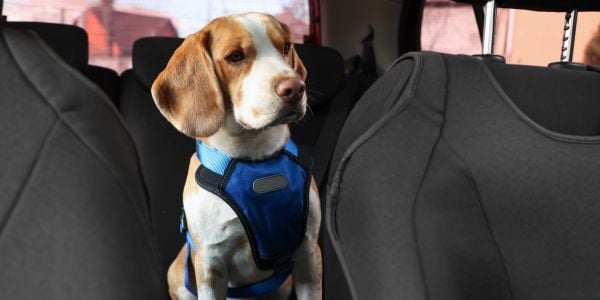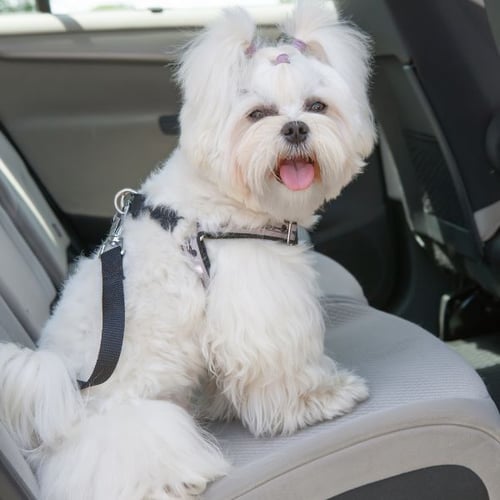
If there was a category in the Guinness World Records for the most times being motion sick, I think I could win. I mean, I get motion-sick just looking at a bus or thinking about sitting in the backseat of a car.
Dogs, just like humans, can suffer from motion sickness during car rides (even short trips) or other types of travel. A queasy dog makes car rides an unpleasant experience for everyone.
A market research study done in 2006 found in that year, about 7.2 million dogs suffered motion sickness. The study also revealed that only 25% (1.8 million) of the dogs received veterinary treatment for the issue. That is way too many dogs suffering and way too few treated.
Knowing how miserable I feel when I get motion sick makes me even more sympathetic to those dogs that suffer from it. It’s important to me that, whenever possible, pet owners take steps to help dogs avoid it. We are here to help you help your pup when riding in the car (or other form of transport) so that everyone has a pleasant experience.
Skip to section:
Why Do Dogs Get Motion Sickness?
With motion sickness, the sensory signals reaching the brain from the eyes (the dog isn’t moving) don’t match the signals reaching the brain from the vestibular movement-sensing areas of the inner ear (the dog is moving), and those mixed signals trigger nausea and vomiting responses.
Since dogs can’t speak, nobody knows for sure why they get motion sickness, but this common problem is usually due to physical and/or psychological reasons.

More commonly than adult dogs, young dogs and puppies get car sick. Just like people, this is likely related to a sense of balance. It may be that the structures of their inner ear involved in balance are not yet fully developed. The good news is that by about 12 months of age, most puppies often outgrow motion sickness. The bad news is some never do.
Psychological reasons, such as car-associated stress or anxiety (going to the vet), tend to be the cause of motion sickness for older dogs. However, it can also relate to the lack of training and desensitization to the abnormal sensation felt when moving inside a car (only one or two trips a year).
Stress and anxiety can cause some to worry the moment the car door opens. If a puppy or older dog associates unpleasant or traumatic situations with a car, it is understandable why they become stressed, anxious, and subsequently sick. Typically, their anxiety about car rides increases with each ride.
Many of the signs and symptoms of car sickness are the same as travel anxiety, so it can be tough to determine exactly which one your dog is experiencing. Plus, some dogs are unlucky enough to be dealing with both.
Most Common Symptoms of Motion Sickness in Dogs
- Drooling
- Panting
- Yawning
- Pacing
- Whining
- Swallowing
- Lip-licking
- Lip-Smacking
- Lethargy (sluggishness)
- Hunched back or other changed body posture
- Lips pulled back and tight facial muscles
- Wide eyes
- Vomiting (in some, but not all, cases)
- Pooping
Treatment for Car Sickness in Dogs
To determine whether your dog’s dislike of car rides is due to motion sickness or travel anxiety, it’s best to start with a visit and conversation with your vet. This can help rule out any underlying medical issues that could mimic the signs of motion sickness and travel anxiety (e.g., pain from a slipped disc or arthritis, an inner or middle ear infection, or high blood pressure). If there’s an underlying medical condition, you’ll want to begin by addressing that.
If there isn’t a medical cause, the visit with your veterinarian will also provide you with an important opportunity to discuss possible medication and/or supplement options to help your dog.
Medications for Motion Sickness
It can sometimes be difficult to determine whether a dog is dealing with motion sickness or, travel anxiety, or both. In these cases, it’s a bit of trial-and-error. Typically, your best bet is to treat for possible motion sickness while also taking steps to help your dog feel more comfortable riding in the car. If your dog’s signs are due exclusively or even primarily to motion sickness, you should notice an improvement in your dog’s signs rather quickly once an effective treatment for motion sickness has been started.
Below are some of the more common medications and supplements used to treat and prevent dog motion sickness. We're highlighting that there are things you can do to help your dog with their car sickness, but do not provide any of these medications to your dog without express instructions from your veterinarian.
Cerenia® (Maropitant)
A highly effective medication for the treatment and prevention of the vomiting associated with motion sickness in dogs. Cerenia is the only veterinary medication specifically licensed for this purpose in dogs and has many years of proven safety and efficacy. A bonus is that Cerenia is non-sedating – so you don’t have to worry about having a “dopey dog.” Cerenia works best when given to dogs 2 hours prior to travel.
Meclizine (Bonine®, Antivert®, Dramamine® LESS Drowsy Formula)
An over-the-counter human antihistamine that can be effective in treating the signs and symptoms of motion sickness in some dogs. As with many antihistamines in its drug class, meclizine can cause drowsiness and “dry mouth” in dogs.
Dimenhydrinate (Dramamine®)
Like meclizine, it is an over-the-counter human antihistamine that can be effective in treating the signs and symptoms of motion sickness in some dogs. As with many antihistamines in its drug class, dimenhydrinate can cause drowsiness and “dry mouth” in dogs.
Diphenhydramine (Benadryl ®)
Another over-the-counter human antihistamine that can be effective in treating the symptoms of motion sickness in some dogs. Similar to meclizine and dimenhydrinate, diphenhydramine can cause drowsiness and “dry mouth” in dogs. It can also cause agitation in some dogs. Once you've spoken with your veterinarian about using Bendaryl® for your dog, use our diphenhydramine calculator to determine your dog's minimum and maximum dosage.
Anti-anxiety Medications
Stress and anxiety can lead to nausea (and sometimes diarrhea). Prescription medications such as Alprazolam, Trazadone, or others can help relax even the most uptight pet travelers. These medications are usually started the evening before travel and repeated 12 hours later. We have a chart of anxiety medications you can consider after discussing this with your veterinarian.
Supplements and Natural Remedies for Motion Sickness
If your dog only seems to have mild issues with motion sickness or in cases where you are unable to get medications from a veterinarian in time for travel, you can try a supplement and/or natural remedy option.
Ginger
Ginger is an herb that has been used for centuries to aid in digestion and help prevent nausea and vomiting. There are plenty of anecdotal reports of it being used successfully for these purposes in dogs, and several studies documenting its effectiveness for helping to control nausea and vomiting associated with pregnancy in women and motion sickness in people in general.
To my knowledge, there haven’t been any specific studies to show the safety and effectiveness of using ginger to help dogs suffering from motion sickness, but many people (and some vets) use and swear by it. The prevailing opinion is that either freshly grated ginger root or ginger root powder is more effective than things like ginger snap cookies and that it's best to give about an hour before travel. Talk to your vet about what dose and frequency are likely to be best for your dog, and make sure that any liquid/tincture formulations you try don't have xylitol in them.
CBD
Some people are using and recommending CBD or hemp oil for dogs suffering from car sickness. A study was done and published in 2023 to test the efficacy of CBD oil in helping dogs lessen stress during car travel. A single dose was found to lessen the effects of acute stress and, therefore, improve emotional well-being.
Additionally, CBD can interfere or interact with certain medications and supplements that your dog is currently on, and the CBD industry, while growing rapidly, is, at this point, very poorly regulated. If you do decide to try CBD to help your dog avoid stress and motion sickness (or for any other reason), please read our What to Know if You Want to Give Your Dog CBD article and consult with your veterinarian first.
Probiotics
The benefits of probiotics stem beyond just maintaining gut health. Besides maintaining the gut, they help heal it. They are recommended for a variety of digestive issues.
A study was conducted in humans to determine if probiotics would aid in seasickness. Intervention with probiotics resulted in a 10% decrease in seasickness. Therefore, it is possible it can do the same for pets.
Research in recent years has made the connection between a pet's gut microbiome and their nervous system, their brain, and, ultimately, behavior. Quality probiotics that have been formulated with this in mind can improve the gut microbiome, thus reducing anxiety and impacting behavior. Additionally, they also help manage stress-induced effects (such as vomiting).
If you try probiotics, like Purina's Calming Care, you'll want to start a month before you intend to travel. It's an easy supplement to use – it can be added on top of your dog's daily meal.
PRO TIP: As you can see above, though there are several over-the-counter, anecdotal, and supplemental treatments for motion sickness in dogs, the fact that maropitant (Cerenia®) is specifically licensed for treating motion sickness in dogs, and is extremely safe and effective is why many vets love this medication for treating motion sickness.
If a dog’s car vomiting doesn’t resolve on Cerenia, then there’s a very high probability that something more (other) than motion sickness is going on.
When the Medication Isn't Helping 100%
If your dog is still showing signs after being treated for travel sickness, they most likely have (at least some degree of) travel anxiety. It could be that their signs were due exclusively to travel anxiety, or there is a component of travel anxiety. If it’s determined that even some of your dog’s symptoms are due to travel anxiety, you can learn more about what you can do to help your dog in our article Preventing and Treating Travel Anxiety in Dogs.

Other Ways to Help Your Dog's Car Sickness
- If not too stressful, have your dog travel on an empty stomach. As a general rule, dogs are less likely to throw up food on an empty stomach, so it’s best to avoid giving them a full meal before you take a ride in the car. Try to withhold food for at least two hours before travel. However, for some dogs, a little bit of food in their stomach (like a teaspoon or two or a couple of treats) may decrease their chances of getting nauseous and vomiting. A little bit of water prior to travel is good; staying hydrated is important, after all.
- About 30 to 60 minutes before leaving, you can spray your car with some calming pheromones and/or place a cotton ball somewhere in the car with a few drops of lavender or chamomile oil to diffuse their calming scent.
Safety Note: It is important to remove the cotton ball prior to your dog getting into the car to avoid them eating it.
- Try giving your dog a small calming treat about 60 minutes before leaving. This can help ease their stress and anxiety before it gets to be too much.
- Be sure the car or mode of travel is quiet, cool, and well-ventilated. To help balance air pressure in the car, lower the windows slightly.
Safety Note: Make sure your dog is restrained so they can’t leap out of or even stick their head out of the window. Sticking their head out the window, regardless of how fun and “free” it looks, puts your dog at risk of severe injuries to their eyes, mouth, throat, and every other part of them that’s sticking out. It’s just not worth the risk.
- Studies have shown playing music can help soothe dogs. Just like people have different tastes in music, so do dogs. Try different options, such as soft rock, reggae, or classical. And if music isn’t their thing, consider an audiobook.
- For puppies and smaller dogs suffering from motion sickness, restraining them in an elevated pet travel booster seat may help them avoid the conflicting sensory signals that can trigger the vomiting of motion sickness. Also, placing the booster seat in the middle of the back seat makes it more likely that they will look forward. You can read about our recommendations for the best types of pet travel booster seats (as well as pet travel harnesses and pet travel crates) in >Buckle Up Your Pup.
- To help pacify and calm your dog, bring along their favorite blanket, toy, or an article of your clothing with your scent on it.
If you have any other tricks that you have found to help your dog not get motion sick, please share them with us.
All of us here at Preventive Vet wish you and your dog safe and healthy travels.



